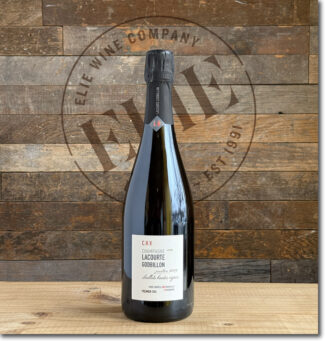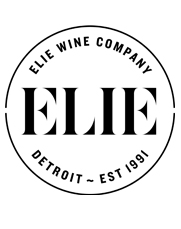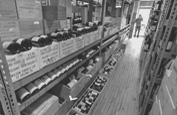The Champagne Society August 2025 Selection: Champagne Lacourte Godbillon
Champagne Lacourte Godbillon
Terroir Evangelism

Champagne Lacourte Godbillon ‘Mi-Pentes’, Petite Montagne-de-Reims Premier Cru Écueil Blanc de Noirs Extra-Brut ($92)
 The soul of Champagne has always been finesse, and a Cellar Master’s decision to balance blends (in a search for complementary aromas and personalities) or to bottle a single variety is intended to be a statement. Listening to the winemaker’s voice in different incarnations of the same art form is to enjoy an ever-changing dialogue between man and grape.
The soul of Champagne has always been finesse, and a Cellar Master’s decision to balance blends (in a search for complementary aromas and personalities) or to bottle a single variety is intended to be a statement. Listening to the winemaker’s voice in different incarnations of the same art form is to enjoy an ever-changing dialogue between man and grape.
Listen to the conversation with your nose and palate and decide which one resonates best with your personality. Society members receive an additional 10% discount of the already discounted prices, so make sure your summer get-togethers are well fueled with ice-breakers.
Elie

Petite Montagne-de-Reims: The Expression of Terroir
In French, the word ‘petite’ often to refers to a ‘lesser’ commodity, but with La Petite Montagne, the reference is to elevation. This lower elevation means warmer weather, even in Champagne’s northerly climate, and in certain villages, the soils contain more sand, making it an ideal environment for growing Meunier.
Meunier accounts for approximately half of the plantings in the Petite Montagne, with Pinot Noir making up 35% and the rest Chardonnay. It is a growing conviction among growers of the modern era that Meunier is a Champagne grape whose time has come, especially as an age-worthy variety. Emmanuel Brochet of Villers-aux-Noeuds says: “People claim that Meunier ages too quickly, even faster than Chardonnay. I disagree. The curve of evolution is different. Meunier is quick to open and more approachable in youth, but then it becomes quite stable. Chardonnay tends to open later, but old Meunier remains very fresh and lively.”

• Petite Montagne-de-Reims • Premier Crus Village Écueil & Les Mesneux
Champagne Lacourte Godbillon
Géraldine Lacourte & Richard Desvignes
Champagne with Roots: Single Parcels, Singular Village
The transition from simply growing grapes to becoming a winemaker who ferments their own crop is taking modern sensibilities by storm, but the family of Géraldine Lacourte took the leap in 1947. Géraldine says, “The Lacourtes on my father’s side and the Godbillons on my mother’s side once sold all their harvest to the major Champagne Houses. It was, perhaps, not a labor of love so much as a labor of survival—my grandmother talked about being in vineyards from five in the morning until eight at night, with the children joining them after school. Then in 1947, shortly after returning from the war, they began a new adventure: Producing and marketing champagne under the names Lacourte-Labasse and Godbillon-Marie. So popular was their wine that they were soon filling their customers’ car boots with bulk orders!”
Géraldine’s parents took the reins in 1968 and established the Champagne Lacourte-Godbillon label. “At first it was no more than a few thousand bottles. Bottling and disgorgement would be done at the back of a courtyard. But the most important thing was my father’s understanding that the best Champagne was made only from top quality work in the vineyard. His whole career was dedicated to this ethos.”

Géraldine Lacourte and Richard Desvignes, Champagne Lacourte Godbillon
In 2006, she and her husband Richard Desvignes left urban jobs and returned to their ancestral roots: “Our 21 acres of vineyards is planted 85% to Pinot Noir and 15% to Chardonnay, all of it in Écueil except for just 1.2 acres in the neighboring village of Les Mesneux. Our vines have an average age of 30 years.”
Richard explains, “Winemakers from all over the Montagne district have long bought Pinot Noir vine plants from Écueil. There was even a school here where they could learn how to graft these stocks. Up until a few years ago we bought our Pinot Noir plants from the local nursery, but going forward, we will be implementing our own ‘massale selection’ of the best plants for cuttings in our own parcels of vines, in order to preserve this heritage.”
The terroir is characterized by an incredibly diverse sub-soil. Some parts are predominantly sandy over the deep chalk, others composed of ‘sparnacian’ clay and shallow chalk at the bottom of the hillsides, similar to the soils of Les Mesneux.
Reframing Champagne: Single Village Premier Cru Écueil
Écueil is one of a string of Premier Cru villages that extend along the slopes of La Petite Montagne. The commune itself has a scant three hundred citizens and covers 1700 acres, of which slightly under four hundred are planted to grape vines. Unlike many of the surrounding villages, Écueil is a Pinot Noir stronghold; Pinot Noir represents 76% of the commune’s production, the remainder being split equally between Chardonnay and Pinot Meunier.
The growers of Écueil are often the lords of tiny holdings, many passed down through generations; they cultivate them meticulously and are deeply connected to their land. As a result, they can boast an intellectual understanding every corner of their vineyards and the personal nuances of the family terroir. To blend away these subtleties with adulterations from other plots, other villages, seems almost silly to those of us who appreciate the reflection of origin.
Single village Champagnes, or ‘monocrus,’ are coming into vogue for this very reason.
The vineyards of Écueil are mostly east-facing, but the several lieux-dits have more southerly exposures. These highly-prized sites have a considerable percentage of sand mixed in with the clay, offering the wines power, lift and elegance. An individual vineyard may have select plots as soils vary from sand atop deep chalk at the top of the slope to clay over shallow chalk at the bottom.
 Champagne Lacourte Godbillon ‘Terroirs d’Ecueil’, Petite Montagne-de-Reims Premier Cru Écueil Extra-Brut ($58)
Champagne Lacourte Godbillon ‘Terroirs d’Ecueil’, Petite Montagne-de-Reims Premier Cru Écueil Extra-Brut ($58)
85% Pinot Noir and 15% Chardonnay grown on the characteristic silty loam soils of Écueil. The wine is a blend of vintages; 47% from 2020, which spent nine months on the lees, and 53% reserve wine from 2019 and 2018. The wine is crisp and racy with acidity, showing notes of citrus, brioche toast and lime zest.
It was bottled July 2021, disgorged on January 2024 and dosed at 3.5 grams per liter, with production at 36,300 bottles.
 Champagne Lacourte Godbillon ”Terroirs Épanouis #2’, Petite Montagne-de-Reims Premier Cru Écueil Extra-Brut ($99)
Champagne Lacourte Godbillon ”Terroirs Épanouis #2’, Petite Montagne-de-Reims Premier Cru Écueil Extra-Brut ($99)
‘Épanouis’ is a dual meaning word, both of which apply: It translates to ‘blossoming’ and ‘contented.’ 85% Pinot Noir, 15% Chardonnay using a base of 44% 2016 reserve, which spent nine months on the lees enhanced with 56% reserve wine from 2015 and 2014. The wine is aromatic with a powerful nose showing toasted almonds and candied fruits, broad and sublime on the palate.
Bottled in July 2016; disgorged January 2024 and dosed at 1.5 grams per liter. A scant production of one thousand bottles.
 Champagne Lacourte Godbillon ‘Mi-Pentes’, Petite Montagne-de-Reims Premier Cru Écueil Blanc de Noirs Extra-Brut (Sold Out)
Champagne Lacourte Godbillon ‘Mi-Pentes’, Petite Montagne-de-Reims Premier Cru Écueil Blanc de Noirs Extra-Brut (Sold Out)
‘Mi-Pentes’ is a French term meaning ‘mid-slope,’ and this is the location of the vines that make up this pure Pinot Noir from Écueil. The wine is a blend of 66% wine from the 2020 vintage which spent nine months on the lees (44% in large oak foudres) and the rest from 2019 reserve.
Bottled in July 2021, using the old ‘tirage sur liège’ method, in which (instead of crown caps) the bottles are sealed with natural cork for their all-important second fermentation; the porosity of the cork allows the wine to mature longer on the lees and thus develop more complexity over a considerable period. Flecks of amber in the hue reflect barrel contact; the wine shows peach, nectarine and toasted nuts.
Disgorged in May 2024 and dosed at 2.5 grams per liter.
Production: 4650 Bottles
 Champagne Lacourte Godbillon ‘R’, Petite Montagne-de-Reims Premier Cru Écueil Rosé Extra-Brut ($64)
Champagne Lacourte Godbillon ‘R’, Petite Montagne-de-Reims Premier Cru Écueil Rosé Extra-Brut ($64)
‘R’ for rosé; 100% Pinot Noir with 6% vin rouge. 55% from the 2021 vintage, which spent nine months sur-lie—40% in large oak barrels—blended with 45% 2020 reserve wine. It was bottled in July 2022 and disgorged May 2024 with 3 grams per liter dosage. The wine shows spicy notes of cinnamon, nutmeg and ginger mingling with blood orange and raspberries.
Production: 5360 Bottles

Precise Champagne: Écueil’s Single Parcels, Lieux-dits
The ‘parcellaire’ approach takes microscopic expressions of a single village even further; site-specific Champagnes celebrate the terroir of an individual vineyard, or even a named portion of a single vineyard, a lieu-dit. In Burgundy, this is common practice; in Champagne (lacking the pervasive marketing tactics of the Grand Marques) it remains an anomaly.
But the consumer will-out, and if these wines take hold of the public’s imagination as firmly as they have done in Burgundy, this style may well dictate the future, especially among those of us who insist that wine reflect the minutia of the soil in which it originates.
The Écueil lieux-dits mentioned above consist of the following:
Les Aillys; a vineyard site immediately to the north of the village itself. Most of the site is south-facing on a gentle slope.
Les Chaillots; a vineyard site in the northern part of Écueil, northwest of the village itself, on the border to Sacy. The site is located in the upper part of the slope, but is rather flat.
Derrière Moutier; an east-facing site situated in the slope immediately above the graveyard, to the west and northwest of it.
Les Gillis; a southeast-sloping vineyard site in the southern part of Écueil, on the border to Chamery. The site is located mid-slope, just above/west of the D26 road.
Les Hautes Vignes; a southeast-facing vineyard site in the southern part of Écueil. It is located immediately above/west of the D26 and borders to Les Gillis in southwest.
Le Mont des Chrétiens; a southeast-sloping vineyard site in the southern part of Écueil, on the border to Chamery. The site is located in the upper part of the slope, close to the edge of the forest, and borders Les Gillis, among others.
 Champagne Lacourte Godbillon ‘C.’, 2016 Petite Montagne-de-Reims Premier Cru Écueil Extra-Brut ($139)
Champagne Lacourte Godbillon ‘C.’, 2016 Petite Montagne-de-Reims Premier Cru Écueil Extra-Brut ($139)
100% Sélection Massale Pinot Noir from the lieu-dit Les Chaillots planted in 1966, a plot prized for its sandy surface and tuffaceous subsoil. The wine was bottled in July, 2017 using the old tirage sur liège method and disgorged on May 9, 2023 with 1.5 grams per liter dosage, and bottled with cork and staple. Rich and refined with notes of fig leaf, black tea and fresh spices blended into a firm, structured palate.
Production: 1658 bottles; 30 Magnums.
 Champagne Lacourte Godbillon ‘C.H.V.’, 2019 Petite Montagne-de-Reims Premier Cru Écueil Blanc de Blancs Extra-Brut ($105)
Champagne Lacourte Godbillon ‘C.H.V.’, 2019 Petite Montagne-de-Reims Premier Cru Écueil Blanc de Blancs Extra-Brut ($105)
‘C.H.V.’ indicates the two lieux-dits sources, Les Chaillots and Les Hautes Vignes, where dual soil types—sables (Les Chaillots) and argiles légères (Les Hautes Vignes) bring their unique personalities to the wine. 100% Chardonnay from the 2019 vintage, vinified in oak barrels, and bottled using gravity, without filtration or fining and aged with cork and staple. Bottled in July 2020, tirage sur liège; disgorged January 2024 and dosed at 2.5 grams per liter. Clean and intense with warm, rich aromas of brioche and roasted almonds and on the palate, honey and minerals on a sustained finish.
Production: 2009 Bottles
 Champagne Lacourte Godbillon ‘C.H.V.’, 2016 Petite Montagne-de-Reims Premier Cru Écueil Blanc de Blancs Extra-Brut 1.5 Liter ($247)
Champagne Lacourte Godbillon ‘C.H.V.’, 2016 Petite Montagne-de-Reims Premier Cru Écueil Blanc de Blancs Extra-Brut 1.5 Liter ($247)
2016 was a rollercoaster vintage, but drawing from the twin lieux-dits of Les Chaillots and Les Hautes Vignes, the House has put together a beautiful Champagne, here in Magnum. Unfiltered, unfined and malo blocked. 100% Chardonnay with nine months sur-lie, 40% in large oak casks. The wine was bottled in July, 2017 and disgorged in October, 2023 with a dosage of 2 grams per liter; it exhibits aromas of warm, freshly-baked bread, lemon oil, white flowers and hazelnuts.
Production: 50 magnums

Premier-Cru Duality: Villages Écueil and Les Mesneux
Les Mesneux is located just below the northwestern part of the Montagne de Reims slope just south of the Reims beltway and rail line. Unlike Pinot-heavy Écueil, Mesneux leans toward Meunier with about 60% of the 118 planted to this varietal; Pinot Noir makes up 33% with the rest Chardonnay. Mesneux terroir is clay-limestone and sandy-loam and produces wines that are known for their delicate precision and focused tension.
 Champagne Lacourte Godbillon ‘Millésime’, 2018 Petite Montagne-de-Reims Premier-Cru Écueil & Premier-Cru Les Mesneux Extra-Brut ($79)
Champagne Lacourte Godbillon ‘Millésime’, 2018 Petite Montagne-de-Reims Premier-Cru Écueil & Premier-Cru Les Mesneux Extra-Brut ($79)
2018 was a legendary vintage in Champagne; this blend of Premier Cru villages show the prolonged summer heatwave in the concentrated aromatics of the nose. 60% Pinot Noir and 40% Chardonnay, the wine spent nine months on the less, 40% of it in 228 liter casks. It was bottled in July, 2019 and disgorged December 14, 2023 and dosed at 2 grams per liter. It displays the elegance and weight of the vintage with crisp fruitiness and spiced notes of cinnamon, licorice and pepper.
Production: 900 Bottles
 Champagne Lacourte Godbillon ‘Millésime’, 2013 Petite Montagne-de-Reims Premier-Cru Écueil & Premier-Cru Les Mesneux Extra-Brut ($173) 1.5 Liter
Champagne Lacourte Godbillon ‘Millésime’, 2013 Petite Montagne-de-Reims Premier-Cru Écueil & Premier-Cru Les Mesneux Extra-Brut ($173) 1.5 Liter
Millésime, of course, is a Champagne term for vintage and indicates that 85% of the grapes came from that specific harvest. 47% Pinot Noir and 53% Chardonnay, 25% fermented in oak from the difficult, but ultimately redeemed 2013 vintage. The grapes had their origin in the estate’s vines in Écueil and Mesneux; the wine was bottled in March 2014 and disgorged in May, 2024 and dosed at 2.5 grams per liter. It shows fruity notes of apples and apricots along with fresh almonds and hazelnuts and hints of coriander seed to add a touch of complexity.
Production 296 magnums.
 Champagne Lacourte Godbillon ‘M.A.M.’, 2016 Petite Montagne-de-Reims Premier-Cru Écueil & Premier-Cru Les Mesneux Brut-Nature ($139)
Champagne Lacourte Godbillon ‘M.A.M.’, 2016 Petite Montagne-de-Reims Premier-Cru Écueil & Premier-Cru Les Mesneux Brut-Nature ($139)
100% Pinot Noir. The abbreviation ‘M.A.M’ signifies the double-barrel terroirs; the lieu-dit Mont Âme is distinguished by its chalky and calcareous soil, contributing to the minerality and Les Migerats, whose rich clay brings plumminess of the fruit into focus. From the 2016 harvest—a tricky vintage that was ultimately better for Pinot Noir than Chardonnay—which spent nine months on the lees. Bottled in July, 2017; disgorged on May 9, 2023 with zero dosage, finished with cork and staple. The wine shows sweet notes of plum tarts and ripe drupes with a refreshing and persistent roundness.
Production: 1834 Bottles, 30 Magnums.
The New Reality: 2009 Indicates Champagne’s Paradigm Shift
Jean-Baptiste Lecaillon of Champagne Louis Roederer has been tracking climate change in Champagne since the year 2000. He reports, “Our archives covering harvests over the past 60 years show that since 1995 Champagne has returned to maturity levels which are, on average, in excess of 10 natural degrees of alcohol, with acidity levels around 7 to 8 gram/liter. These levels are close to those traditionally seen for great vintages including 1945, 1947 and 1959, but today’s yields are sometimes three to four times higher.”
Harvest dates in the vineyards of Champagne are among the marks used to measure climate change in general. Since 1989 (the end of a cool temperature cycle) harvest dates have crawled gradually backwards and the 2007 harvest started on August 20. By comparison, in 1945, the harvest commenced on September 8 and the 1947 harvest started on September 2, whilst harvests in the late 1980s were in early October. Harvest dates have grown earlier in each of recent years as means of controlling grape characteristics. Winemakers have been relying on newer techniques to obtain fresher wines as the raw material becomes riper. They are careful to manage malolactic fermentation, sometimes doing only partial MLF or halting it altogether.
Vintage 2009 represents the paradigm shift sweeping the region; in ways, a return to the golden years. It began with a cold winter, but a mild spring, and although early summer saw variable weather, August and September brought ample sunshine and warmth contributing to fine grape health. Harvest was pushed back until September 8, and the grapes, in general, displayed high sugar content and soft acidity. Potential alcohol crept up to 10.3% while acidity remained at 7.5 gram/liter at a pH of 3.08.
2009 produced a voluminous crop (12,280 kilogram/hectare) and the wines are generous that showed impressively even as vin clair. It is an apt example of a vintage of the current era, when retaining freshness is more of a challenge than attaining ripeness.
Drawing The Boundaries of The Champagne Region
To be Champagne is to be an aristocrat. Your origins may be humble and your feet may be in the dirt; your hands are scarred from pruning and your back aches from moving barrels. But your head is always in the stars.
As such, the struggle to preserve its identity has been at the heart of Champagne’s self-confidence. Although the Champagne controlled designation of origin (AOC) wasn’t recognized until 1936, defense of the designation by its producers goes back much further. Since the first bubble burst in the first glass of sparkling wine in Hautvillers Abbey, producers in Champagne have maintained that their terroirs are unique to the region and any other wine that bears the name is a pretender to their effervescent throne.
Having been defined and delimited by laws passed in 1927, the geography of Champagne is easily explained in a paragraph, but it takes a lifetime to understand it.
Ninety-three miles east of Paris, Champagne’s production zone spreads across 319 villages and encompasses roughly 85,000 acres. 17 of those villages have a legal entitlement to Grand Cru ranking, while 42 may label their bottles ‘Premier Cru.’ Four main growing areas (Montagne de Reims, Vallée de la Marne, the Côte des Blancs and the Côte des Bar) encompass nearly 280,000 individual plots of vines, each measuring a little over one thousand square feet.
The lauded wine writer Peter Liem expands the number of sub-regions from four to seven, dividing the Vallée de la Marne into the Grand Vallée and the Vallée de la Marne; adding the Coteaux Sud d’Épernay and combining the disparate zones between the heart of Champagne and Côte de Bar into a single sub-zone.

Courtesy of Wine Scholar Guild
Lying beyond even Liem’s overview is a permutation of particulars; there are nearly as many micro-terroirs in Champagne as there are vineyard plots. Climate, subsoil and elevation are immutable; the talent, philosophies and techniques of the growers and producers are not. Ideally, every plot is worked according to its individual profile to establish a stamp of origin, creating unique wines that compliment or contrast when final cuvées are created.
Champagne is predominantly made up of relatively flat countryside where cereal grain is the agricultural mainstay. Gently undulating hills are higher and more pronounced in the north, near the Ardennes, and in the south, an area known as the Plateau de Langres, and the most renowned vineyards lie on the chalky hills to the southwest of Reims and around the town of Épernay. Moderately steep terrain creates ideal vineyard sites by combining the superb drainage characteristic of chalky soils with excellent sun exposure, especially on south and east facing slopes.
… Yet another reason why this tiny slice of northern France, a mere 132 square miles, remains both elite and precious.
- - -
Posted on 2025.08.04 in France, The Champagne Society, Champagne
Featured Wines
- Notebook: A’Boudt Town
- Saturday Sips Wines
- Saturday Sips Review Club
- The Champagne Society
- Wine-Aid Packages
Wine Regions
Grape Varieties
Aglianico, Albarino, Albarín Blanco, Albarín Tinto, Albillo, Aleatico, Arbanne, Arcos, Aubun, Barbarossa, barbera, Beaune, Biancu Gentile, bourboulenc, Cabernet Franc, Cabernet Sauvignon, Caino, Caladoc, Calvi, Carcajolu-Neru, Carignan, Chablis, Chardonnay, Chasselas, Clairette, Corvina, Cot, Counoise, Erbamat, Ferrol, Fiano, Frappato, Friulano, Fromenteau, Fumin, Garnacha, Gewurztraminer, Godello, Graciano, Grenache, Grolleau, Groppello, Juan Garcia, Lambrusco, Loureira, Macabeo, Macabou, Malvasia, Malvasia Nera, Marsanne, Marselan, Marzemino, Melon de Bourgogne, Merlot, Mondeuse, Montanaccia, Morescola, Morescono, Moscatell, Muscat, Natural, Nero d'Avola, Palomino, Parellada, Patrimonio, Petit Meslier, Petit Verdot, Pineau d'Aunis, Pinot Auxerrois, Pinot Blanc, Pinot Gris, Pinot Meunier, Pinot Noir, Poulsard, Prieto Picudo, Rondinella, Rose, Rousanne, Roussanne, Sauvignon Blanc, Savignin, Semillon, Souson, Sparkling, Sumoll, Sylvaner, Syrah, Tannat, Tempranillo, Trebbiano, Trebbiano Valtenesi, Treixadura, Trousseau, Ugni Blanc, vaccarèse, Verdicchio, Vermentino, Viognier, Viura, Xarel-loWines & Events by Date
- September 2025
- August 2025
- July 2025
- June 2025
- May 2025
- April 2025
- March 2025
- February 2025
- January 2025
- December 2024
- November 2024
- October 2024
- September 2024
- August 2024
- July 2024
- June 2024
- May 2024
- April 2024
- March 2024
- February 2024
- January 2024
- December 2023
- November 2023
- October 2023
- September 2023
- August 2023
- July 2023
- June 2023
- May 2023
- April 2023
- March 2023
- February 2023
- January 2023
- December 2022
- November 2022
- October 2022
- September 2022
- August 2022
- July 2022
- June 2022
- May 2022
- April 2022
- March 2022
- February 2022
- January 2022
- December 2021
- November 2021
- October 2021
- September 2021
- August 2021
- July 2021
- June 2021
- May 2021
- April 2021
- March 2021
- February 2021
- January 2021
- December 2020
- November 2020
- October 2020
- September 2020
- August 2020
- July 2020
- June 2020
- May 2020
- April 2020
- March 2020
- February 2020
- January 2020
- December 2019
- November 2019
- October 2019
- September 2019
- August 2019
- July 2019
- June 2019
- May 2019
- April 2019
- March 2019
- February 2019
- January 2019
- December 2018
- November 2018
- October 2018
- September 2018
- August 2018
- July 2018
- June 2018
- May 2018
- April 2018
- March 2018
- February 2018
- January 2018
- December 2017
- November 2017
- October 2017
- September 2017
- August 2017
- July 2017
- June 2017
- May 2017
- April 2017
- March 2017
- February 2017
- January 2017
- December 2016
- November 2016
- October 2016
- September 2016
- August 2016
- July 2016
- June 2016
- May 2016
- April 2016
- March 2016
- February 2016
- January 2016
- December 2015
- November 2015
- October 2015
- September 2015
- August 2015
- July 2015
- June 2015
- May 2015
- April 2015
- March 2015
- February 2015
- January 2015
- December 2014
- November 2014
- October 2014
- September 2014
- August 2014
- July 2014
- June 2014
- April 2014
- March 2014
- February 2014
- January 2014
- December 2013
- November 2013
- October 2013
- September 2013
- August 2013
- July 2013
- June 2013
- May 2013
- April 2013
- March 2013
- February 2013
- January 2013
- December 2012
- November 2012
- October 2012
Search



